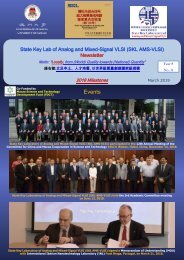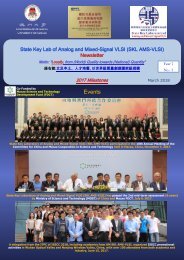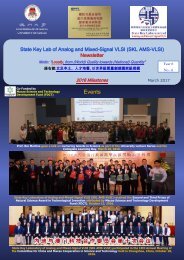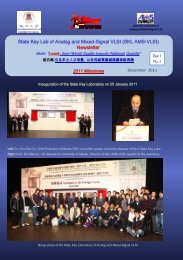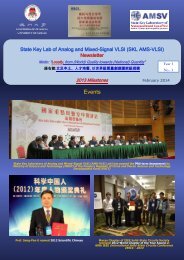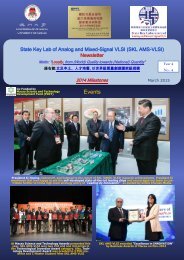AMSV Newsletter 2015
AMSV Newsletter 2015
AMSV Newsletter 2015
You also want an ePaper? Increase the reach of your titles
YUMPU automatically turns print PDFs into web optimized ePapers that Google loves.
Sensor<br />
Conventional<br />
Proposed<br />
Conventional<br />
Proposed<br />
In TPEL <strong>2015</strong><br />
Self-reconfiguration property of a mixed signal controller for<br />
improving power quality compensator during light loading<br />
Man-Chung Wong, Yan-Zheng Yang, Chi-Seng Lam, Wai-Hei Choi, Ning-Yi Dai, Ya-jie Wu,<br />
Chi-Kong Wong, Sai-Weng Sin, U-Fat Chio, Seng-Pan U, R.P. Martins<br />
From Integrated Power research line<br />
Motivation<br />
Currently, when compensator performance<br />
does not satisfy international standards, other<br />
PWMs can be selected, or the dc link voltage<br />
can be increased. However, it may be the case<br />
that neither of these methods will improve compensator<br />
performance during light loading due<br />
to the low resolution of the input signals compared<br />
with the error signal and the PWM error<br />
margin. The design of digital controllers is usually<br />
based on a full loading situation. The full<br />
analog-to-digital (A/D) conversion input signal<br />
range of a digital controller is therefore utilized,<br />
to avoid analog signal saturation. In a light load<br />
situation, the digital controller may suffer from<br />
the problem of low resolution, which significantly<br />
affects its compensation performance. There<br />
is presently no achievable control strategy to<br />
deal with power quality compensation issues<br />
during light loading.<br />
Architecture<br />
A mixed signal controller for power quality compensator is proposed for enhancing<br />
the advanced performance that cannot be achieved by analog or<br />
digital controller alone and independently. Several special features can be<br />
achieved by mixed signal controller are given as follows:<br />
▓ Adaptive Signal Conditioning and Programmability on-the-Fly<br />
▓ Parallelism Properties and Higher Redundancy<br />
▓ Higher Accuracy, Higher Bandwidth, Faster Response Time and Low<br />
Power<br />
▓ Algorithm Complexity and Simplicity of Implementation<br />
The FPAA can be operated as an adaptive signal conditioning unit that preconditions<br />
and filters, according to the optimization of system performance.<br />
The modified signals then pass to the digital unit for further processing, assisted<br />
by the ADC. The digital system, FPGA/DSP, can work with a “backer”<br />
sub-program to optimize the system operation by reconfiguring the control<br />
system automatically, or to carry out self-testing and self-repairing tasks.<br />
When it is necessary to reconfigure the analog part, the re-programming data<br />
can be transferred directly through the digital path to the FPAA. Conversely,<br />
the FPAA can also send out control signals to the FPGA to modify the algorithm<br />
for protection, critical operations, etc.<br />
Input Signals<br />
vLa, vLb, vLc<br />
iLa, iLb, iLc<br />
iCa, iCb, iCc<br />
FPAA<br />
Mixed Signal Controller<br />
vLa, vLb, vLc<br />
iLa, iLb, iLc<br />
iCa, iCb, iCc<br />
Gain Saturation<br />
Signal<br />
ADC<br />
Reconfigurable<br />
Gain G<br />
FPGA/<br />
DSP<br />
PWM Signals<br />
Ta,Ta<br />
Tb,Tb<br />
Tc,Tc<br />
Analog Signal Paths<br />
Digital Signal Paths<br />
Implementation<br />
Verification<br />
The proposed mixed signal controller is tested in a threephase<br />
four-wire hybrid active power filter (HAPF) system in<br />
comparison with a conventional digital controller.<br />
v sa<br />
v sb<br />
L s<br />
i sn<br />
i sb<br />
i sc<br />
v La<br />
v Lb<br />
v Lc<br />
ica<br />
icb<br />
icc<br />
i La<br />
i Lb<br />
i Lc<br />
A<br />
B Loads N<br />
C<br />
i Ln<br />
A<br />
N<br />
B<br />
N<br />
C<br />
N<br />
LLa<br />
LLb<br />
LLc<br />
RLa<br />
RLb<br />
RLc<br />
Inductive<br />
Linear Load<br />
IEEE Standard (




